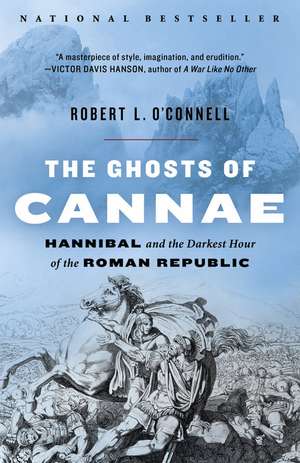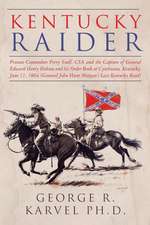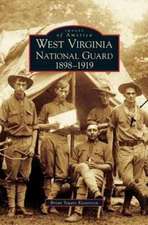The Ghosts of Cannae: Hannibal and the Darkest Hour of the Roman Republic
Autor Robert L. O'Connellen Limba Engleză Paperback – 31 aug 2011
For millennia, Carthage’s triumph over Rome at Cannae in 216 B.C. has inspired reverence and awe. No general since has matched Hannibal’s most unexpected, innovative, and brutal military victory. Now Robert L. O’Connell, one of the most admired names in military history, tells the whole story of Cannae for the first time, giving us a stirring account of this apocalyptic battle, its causes and consequences.
O’Connell brilliantly conveys how Rome amassed a giant army to punish Carthage’s masterful commander, how Hannibal outwitted enemies that outnumbered him, and how this disastrous pivot point in Rome’s history ultimately led to the republic’s resurgence and the creation of its empire. Piecing together decayed shreds of ancient reportage, the author paints powerful portraits of the leading players, from Hannibal—resolutely sane and uncannily strategic—to Scipio Africanus, the self-promoting Roman military tribune. Finally, O’Connell reveals how Cannae’s legend has inspired and haunted military leaders ever since, and the lessons it teaches for our own wars.
Preț: 97.74 lei
Nou
Puncte Express: 147
Preț estimativ în valută:
18.71€ • 19.46$ • 15.44£
18.71€ • 19.46$ • 15.44£
Carte disponibilă
Livrare economică 24 martie-07 aprilie
Preluare comenzi: 021 569.72.76
Specificații
ISBN-13: 9780812978674
ISBN-10: 0812978676
Pagini: 310
Ilustrații: 6 MAPS
Dimensiuni: 132 x 203 x 18 mm
Greutate: 0.27 kg
Editura: Random House Trade
ISBN-10: 0812978676
Pagini: 310
Ilustrații: 6 MAPS
Dimensiuni: 132 x 203 x 18 mm
Greutate: 0.27 kg
Editura: Random House Trade
Notă biografică
Robert L. O’Connell has worked as a senior analyst at the National Ground Intelligence Center, as a contributing editor to MHQ: The Quarterly Journal of Military History, and most recently as a visiting professor at the Naval Postgraduate School. He is the author of Of Arms and Men: A History of War, Weapons, and Aggression; Sacred Vessels: The Cult of the Battleship and the Rise of the U.S. Navy; Ride of the Second Horseman: The Birth and Death of War; Soul of the Sword: An Illustrated History of Weaponry and Warfare from Prehistory to the Present; and the novel Fast Eddie.
From the Hardcover edition.
From the Hardcover edition.
Extras
Chapter One
Traces of War
Polybius of Megalopolis peered down from a pass high in the Italian Alps and caught sight of the rich green Lombard plain far below. It was exactly the same inviting panorama Hannibal had shown his half-starved, half-frozen, thoroughly discouraged army seventy-three years before, exhorting them to stay the course on what would prove to be an amazing path of conquest. Quite probably enough bits and pieces of that weary host remained visible for Polybius to be sure he was in the right spot; a certitude denied future chroniclers, and giving rise to one of ancient history’s most enduring and futile controversies: Where exactly did Hannibal cross the Alps?1 Polybius, for his part, was free to concentrate on questions he found more important. It was his aim—an endeavor that would eventually fill forty books—to explain to his fellow Greeks how a hitherto obscure city-state on the Italian peninsula had come to dominate, virtually in the course of a lifetime, the entire Mediterranean world. But if Rome stood at center stage in Polybius’s inquiry, Hannibal and Carthage were his foils. Each in their own way had nearly put an end to Rome’s ambitions. Both by this time were dead, obliterated by Rome, but it was the challenges they had posed and the disasters they had inflicted that Polybius found most compelling. For no matter how bad things had gotten, Rome had always responded, had picked itself up out of the dustbin of history and soldiered on. And it was in defeat more than victory that Polybius saw the essence of Rome’s greatness.
It never got worse than Cannae. On August 2, 216 b.c., a terrible apocalyptic day in southern Italy, 120,000 men engaged in what amounted to a mass knife fight. At the end of the fight, at least forty-eight thousand Romans lay dead or dying, lying in pools of their own blood and vomit and feces, killed in the most intimate and terrible ways, their limbs hacked off, their faces and thoraxes and abdomens punctured and mangled. This was Cannae, an event celebrated and studied as Hannibal’s paragon by future practitioners of the military arts, the apotheosis of the decisive victory. Rome, on the other hand, lost—suffering on that one day more battle deaths than the United States during the entire course of the war in Vietnam, suffering more dead soldiers than any other army on any single day of combat in the entire course of Western military history. Worse yet, Cannae came at the end of a string of savage defeats engineered by the same Hannibal, Rome’s nemesis destined to prey on Italy for another thirteen years and defeat army after army and kill general after general. Yet none of this would plumb the depths reached on that awful afternoon in August.
It has been argued that Polybius, aware of Cannae’s enormous symbolic import, deliberately structured his history so as to make the battle appear as the absolute low point in Rome’s fortunes, thereby exaggerating its significance.2 Yet, not only do sheer numbers argue the contrary, but also Rome on this day lost a significant portion of its leadership class, between a quarter and a third of the senate, the members of which had been anxious to be present at what had been assumed would be a great victory. Instead it was a debacle by any measure, so much so that a case can be made that Cannae was even more critical than Polybius believed, in retrospect a true pivot point in Roman history. Arguably the events of this August day either initiated or accelerated trends destined to push Rome from municipality to empire, from republican oligarchy to autocracy, from militia to professional army, from a realm of freeholders to a dominion of slaves and estates. And the talisman of all of this change was one lucky survivor, a young mili- tary tribune named Publius Cornelius Scipio,* known to history as Africanus. For at the end of many more years of fighting, Rome still would need a general and an army good enough to defeat Hannibal, and Scipio Africanus, with the help of what remained of the battlefield’s disgraced refugees, would answer the call and in the process set all else in motion.
* Typical Roman names of the late republican period had three elements: a praenomen, or given name (in this case Publius), chosen from a limited list and having no family connotation; a nomen, referring to the gens or clan name (Cornelii); and, finally, the cognomen, or family within the clan (Scipio).
From the Hardcover edition.
Traces of War
Polybius of Megalopolis peered down from a pass high in the Italian Alps and caught sight of the rich green Lombard plain far below. It was exactly the same inviting panorama Hannibal had shown his half-starved, half-frozen, thoroughly discouraged army seventy-three years before, exhorting them to stay the course on what would prove to be an amazing path of conquest. Quite probably enough bits and pieces of that weary host remained visible for Polybius to be sure he was in the right spot; a certitude denied future chroniclers, and giving rise to one of ancient history’s most enduring and futile controversies: Where exactly did Hannibal cross the Alps?1 Polybius, for his part, was free to concentrate on questions he found more important. It was his aim—an endeavor that would eventually fill forty books—to explain to his fellow Greeks how a hitherto obscure city-state on the Italian peninsula had come to dominate, virtually in the course of a lifetime, the entire Mediterranean world. But if Rome stood at center stage in Polybius’s inquiry, Hannibal and Carthage were his foils. Each in their own way had nearly put an end to Rome’s ambitions. Both by this time were dead, obliterated by Rome, but it was the challenges they had posed and the disasters they had inflicted that Polybius found most compelling. For no matter how bad things had gotten, Rome had always responded, had picked itself up out of the dustbin of history and soldiered on. And it was in defeat more than victory that Polybius saw the essence of Rome’s greatness.
It never got worse than Cannae. On August 2, 216 b.c., a terrible apocalyptic day in southern Italy, 120,000 men engaged in what amounted to a mass knife fight. At the end of the fight, at least forty-eight thousand Romans lay dead or dying, lying in pools of their own blood and vomit and feces, killed in the most intimate and terrible ways, their limbs hacked off, their faces and thoraxes and abdomens punctured and mangled. This was Cannae, an event celebrated and studied as Hannibal’s paragon by future practitioners of the military arts, the apotheosis of the decisive victory. Rome, on the other hand, lost—suffering on that one day more battle deaths than the United States during the entire course of the war in Vietnam, suffering more dead soldiers than any other army on any single day of combat in the entire course of Western military history. Worse yet, Cannae came at the end of a string of savage defeats engineered by the same Hannibal, Rome’s nemesis destined to prey on Italy for another thirteen years and defeat army after army and kill general after general. Yet none of this would plumb the depths reached on that awful afternoon in August.
It has been argued that Polybius, aware of Cannae’s enormous symbolic import, deliberately structured his history so as to make the battle appear as the absolute low point in Rome’s fortunes, thereby exaggerating its significance.2 Yet, not only do sheer numbers argue the contrary, but also Rome on this day lost a significant portion of its leadership class, between a quarter and a third of the senate, the members of which had been anxious to be present at what had been assumed would be a great victory. Instead it was a debacle by any measure, so much so that a case can be made that Cannae was even more critical than Polybius believed, in retrospect a true pivot point in Roman history. Arguably the events of this August day either initiated or accelerated trends destined to push Rome from municipality to empire, from republican oligarchy to autocracy, from militia to professional army, from a realm of freeholders to a dominion of slaves and estates. And the talisman of all of this change was one lucky survivor, a young mili- tary tribune named Publius Cornelius Scipio,* known to history as Africanus. For at the end of many more years of fighting, Rome still would need a general and an army good enough to defeat Hannibal, and Scipio Africanus, with the help of what remained of the battlefield’s disgraced refugees, would answer the call and in the process set all else in motion.
* Typical Roman names of the late republican period had three elements: a praenomen, or given name (in this case Publius), chosen from a limited list and having no family connotation; a nomen, referring to the gens or clan name (Cornelii); and, finally, the cognomen, or family within the clan (Scipio).
From the Hardcover edition.
Recenzii
“A masterpiece of style, imagination, and erudition.”—Victor Davis Hanson, author of A War Like No Other
“Outstanding . . . [a] superb chronicle of events that shaped the fate of Western civilization.”—Booklist
“[O’Connell] is able to put himself and his reader on the ground at Cannae, gagging in the heat of a southern Italian midsummer, assailed by an overload from every one of the five senses.”—The New York Times Book Review
“Dramatic and comprehensive . . . O’Connell has established the new standard for studies of the second conflict between Rome and Carthage.”—Publishers Weekly
“[O’Connell] writes with clarity about an era shrouded in speculation.”—Providence Journal-Bulletin
“Outstanding . . . [a] superb chronicle of events that shaped the fate of Western civilization.”—Booklist
“[O’Connell] is able to put himself and his reader on the ground at Cannae, gagging in the heat of a southern Italian midsummer, assailed by an overload from every one of the five senses.”—The New York Times Book Review
“Dramatic and comprehensive . . . O’Connell has established the new standard for studies of the second conflict between Rome and Carthage.”—Publishers Weekly
“[O’Connell] writes with clarity about an era shrouded in speculation.”—Providence Journal-Bulletin

















